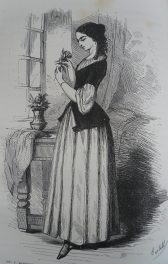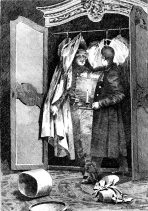
The Maranas
THE HUMAN COMEDY – Honoré de Balzac XVth volume of works of Honoré de Balzac edited by widow André Houssiaux, publisher, Hebert and Co, successors, 7 rue Perronet – Paris (1874)
Philosophical studies

Juana
THE MARANAS (1832 ) – (woman study)
Dedicated work TO COUNTESS MERLIN
Analysis and history It’s a long story by Balzac, first published in two chapters in the Revue de Paris in 1832, then again in the same journal in 1833. Les Marana was published in bookshops in 1834 by Madame Béchet, then in 1846 in the Furne edition of La Comédie Humaine, in Volume II of the ” Etudes philosophiques ” along with Adieu, L’Enfant maudit and Le Réquisitionnaire. The beginning is similar to Contes bruns, published in collaboration the same year, which contained military reminiscences later dispersed among several of his works. The central section could be one of the many “études de femme” that Balzac wrote during this period. The ending is melodramatic. The subject can be summed up in one word: an unhappily married girl, who comes to despise her husband despite her efforts to help him and be faithful to him, finally kills him to spare her children dishonor. Unfortunately, this drama of motherhood rests on a scaffolding of disparate events and feelings that makes the story implausible without managing to give it any depth. First, a backdrop that sets the theme. The young woman is the daughter of a centuries-old line of great courtesans, the “Marana”. Her mother adores her, wants to take her away from the family vocation, and hands her over as a sacred trust to a Spanish household she has saved. Lighting, a miraculous gift that Balzac regards as a physiological case : this mother, who leads her lavish life across Spain and Italy, who refuses all contact with her beloved daughter, has an infallible instinct that warns her when her daughter is in danger and makes her intervene immediately. The plot: the French takeover of Tarragona in 1807, the fortunes of the occupation, a lodging ticket, a seduction, the mother shows up, the seducer escapes, the mother immediately finds a husband. This is the first part, the prologue to the “Etude de femme”. Second part: life with the husband the daughter doesn’t love, but with whom she wants to be loyal, an admirable “scene of private life” that Balzac is obliged to sum up in fifteen pages, whereas he would need a volume to paint the disappointment, the courage, the degradation, the estrangement. In this sinister and sumptuous life – the father becomes a businessman – the wife has only one consolation, two children, one of whom is that of the lover who seduced her. The denouement: the husband is scorned as a businessman, realizes that his wife lives only for her children, starts gambling, loses his fortune. In the end, he plays a double-or-nothing game with his wife’s seducer, whom he finds, loses and kills in order to rob him and run off with the robbery money. He was pursued, fled to his wife and confessed; his wife, to save the name and future of her children, shot him dead with a pistol before the police arrived. The coroner understands everything and concludes that it was suicide. The central part could have been very beautiful if Balzac had had a hundred and fifty pages to develop it. But time was short, and so were the conditions for publication in the Revue de Paris, where the number of pages was limited. These were the same constraints that, ten years later, and for the same reasons, were to cause him to miss the beautiful subject of Z. Marcas. There are subjects that are admirable themes for a novel, but are inevitably stifled within the narrow confines of a short story. Balzac was no less proud of the result. In the words of Félix Davin: “L’Histoire de Mme Diard (the title of the central chapter) is one of those pieces that should make both men and women dream. “She is,” added his spokesman, “prodigious in her talent for analysis. But at the same time, he couldn’t help writing a phrase that would be found in the novel itself: “Wouldn’t this analysis, in which every wife would have to find some of her own sufferings in order to understand them all, be a whole book?”
The characters Marana: Dynasty of Italian courtesans. One of them, Belle Romaine, in the 16th century, had a natural daughter by the Duc d’Hérouville, who married Beauvouloir. Another, at the end of the 18th century, had a natural but recognized daughter by Mancini, who married Diard, hence the aforementioned Histoire de Madame Diard. The story of Madame Diard Emigrants to Spain, where they found refuge after being expelled from Venice, the Marana family’s destiny has always been to live off their charms. To put an end to this destiny, and allow her daughter Juana Mancini to have hopes of marriage, she entrusted her education to a family of cloth merchants, the Pérez de Lagounia. Her hopes are threatened by the arrival of Captain Montefiore, who seduces Juana and bears her a child. Montefiore will never recognize little Juan, whose stepfather will be Captain Diard. Now Madame Diard, Juana gave birth to a little Francisque. Monsieur Diard leaves the army to go into business in Paris. These were bad, and the poor husband decided to try his luck in Bordeaux, and from there to the Pyrenees. A gambler, he meets his old friend Montefiore along the way, who ruins his gambling for good.  Montefiore: Italian soldier murdered around 1826. Married an Englishwoman. Montefiore is Juan Diard’s real father. Diard: Military, then businessman, killed by his wife around 1826. Married Juana Mancini in 1811, from whom : Juan, actually Captain Montefiore’s son; Francisque. Pérez de Lagounia: Spanish family from Tarragona, adoptive parents of Juana Mancini.
Montefiore: Italian soldier murdered around 1826. Married an Englishwoman. Montefiore is Juan Diard’s real father. Diard: Military, then businessman, killed by his wife around 1826. Married Juana Mancini in 1811, from whom : Juan, actually Captain Montefiore’s son; Francisque. Pérez de Lagounia: Spanish family from Tarragona, adoptive parents of Juana Mancini.
1) Source analysis/history: Preface from the 24th volume of La Comédie Humaine published by France Loisirs in 1987, based on the full text published under the auspices of the Société des Amis d’Honoré de Balzac, 45, rue de l’Abbé-Grégoire – 75006 Paris.
2) Genealogical research and notes on the Histoire de Madame Diard are taken from Wikipedia and Félicien Marceau’s “Balzac et son monde – Gallimard”.
No Comments